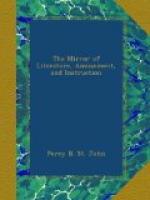As an evidence of the great desire of the natives of both sexes to leave their native land, I may mention the offers which were made to the commander of the ship, of baskets of potatoes and hogs, as an inducement to be carried to the island of Erromanga, where our vessel was next bound to. Two hundred were taken on board for the purpose of cutting Sandal wood, but from the unhealthy state in which we found the island on our arrival, and the numerous deaths that had occurred among native gangs that had been brought by other vessels for a similar purpose, we returned to Rotuma and landed them all safely. The perfect apathy with which they leave parents and connexions, departing with strangers to a place respecting which they are in total ignorance, is quite surprising, placing an unbounded confidence in those differing in colour, language, and customs from themselves: the young, timid females, to whom a ship was a novelty, those who had never before seen a ship, were all anxious to visit foreign climes,—even, they said, London.
Much wonder was excited, when I exhibited to the natives of this island coloured engravings of flowers, birds, butterflies, &c.; they imagined them to be the original plant or butterfly attached to the paper—no mean compliment to the artist. The engravings in Charles Bell’s Anatomy of Expression always excited much interest when shown to the Polynesians; the plate representing Laughter never failed of exciting sympathy. A caricature representation of one of the fashionable belles of 1828 puzzled them exceedingly; some thought it “a bird,” others that it was a nondescript of some kind, but when they were told that it was a Haina London, or English lady, they laughed, and said Parora, “you are in joke,” so incredible did it seem to their unsophisticated minds.[11]
[10] From a drawing, obligingly
furnished by Mr. George Bennett,
Member of the Royal College of Surgeons in
London, &c.
[11] Abridged from the United Service Journal.
* * * * *
MOUNT ARARAT.
A short time since there were given in the St. Petersburgh Academical Journal some authentic particulars of Professor Parrot’s journey to Mount Ararat. After being baffled in repeated attempts, he at length succeeded in overcoming the obstacles which beset him, and ascertained the positive elevation of its peak to be 16,200 French feet: it is, therefore, more than 1,500 feet loftier than Mount Blanc. He describes the summit as being a circular plane, about 160 feet in circumference, joined by a gentle descent, with a second and less elevated one towards the east. The whole of the upper region of the mountain, from the height of 12,750 English feet, being covered with perpetual snow and ice. He afterwards ascended what is termed “The Little Ararat,” and reports it to be about 13,100 English feet high.—W.G.C.




